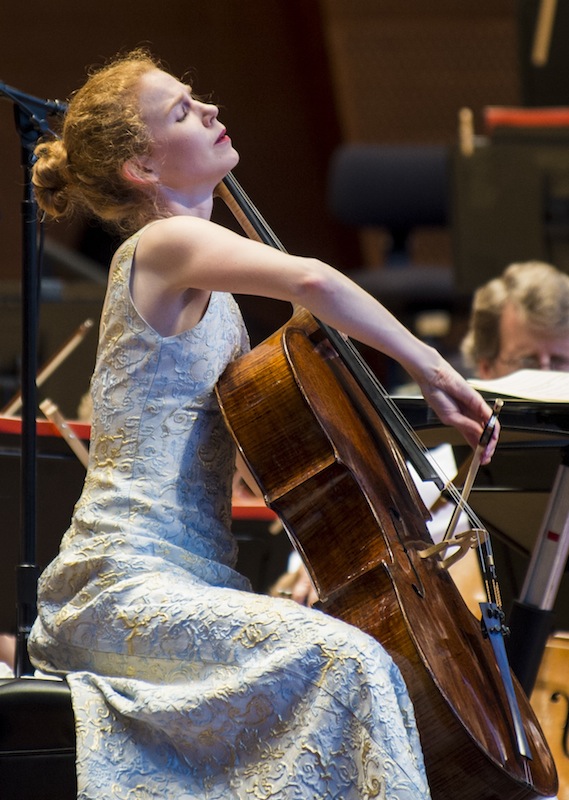A cellist’s impressive debut and a neglected American composer at Grant Park Music Festival

This summer’s Grant Park Music Festival has been lighter on 20th-century American works than in recent years. But Carlos Kalmar and the Grant Park Orchestra nicely made up the balance by presenting George Chadwick’s Symphonic Sketches on a drizzly Wednesday night at the Pritzker Pavilion.
The trend in recent decades has been to raise high the reputation of the iconoclastic Charles Ives, yet perhaps too often at the expense of his contemporaries. Many observers continue to deride the composers of the Boston-centered “New England School” (Horatio Parker, Amy Beach, Arthur Foote, and Edward MacDowell) for their tonal, conservative style.
Born in Lowell, Massachusetts, George Whitefield Chadwick (1854-1931) was prolific and composed in most genres. His output includes five operas and an operetta, three symphonies, five string quartets, songs, choral anthems and a great deal of orchestral music.
Among the latter is the Symphonic Sketches— effectively a picturesque, thirty-minute symphony in four sections including slow movement and scherzo. Though “Jubilee” and “Noël” have been played previously at Grant Park, Wednesday night’s performance marked the belated festival premiere of the complete work.
The Symphonic Sketches (completed in 1904) may not be among Chadwick’s most individual or profound efforts—the shadows of Brahms and, especially, Dvořák loom large, as in much American music of the period. But the Sketches are tuneful, crafted with flair, and well-suited for al fresco music-making.
Kalmar and the Grant Park Orchestra brought characteristic commitment to Chadwick’s music. “Jubilee”–the first and most excerpted section–was suitably rousing, the first theme invested with high-stepping vitality, and the rich vein of nostalgia conveyed in the homespun second theme. “Noël” was especially lovely with the glowing English horn and violin solos bringing out the sweet-sad expression, which Kalmar built to a ripely Romantic outpouring.
The light-hearted humor of “Hobgoblin” was duly spirited. The closing section, “A Vagrom Ballad” is the weakest part of the Sketches, but Kalmar and colleagues brought such fervor and commitment to the episodic sequences that it made a largely effective finale.
The evening began with two works for chamber orchestra that take inspiration from Baroque music.
Harriet Krijgh has been making the rounds of major U.S orchestras in recent seasons, and the young Dutch cellist served up a notable local bow in music of Haydn.
Like many early Haydn concertos, his Cello Concerto in C major has feet planted in two musical eras. The first movement’s stately ripieno alternation is a vestige of Baroque style while the slow movement and bravura finale point the way forward to the Classical, and even Romantic eras.
Krijgh possesses a remarkable technique, which remained intact even on a moist, humid evening, and she performed with faultless intonation and even articulation. It certainly didn’t hurt to be playing Haydn’s concerto on a magnificent, nearly 500-year-old instrument; her 1620 Giovanni Paolo Maggini cello, on private loan, offered striking richness and depth with a wide range of tonal hues.
The rum-ti-tum of the opening Moderato can be dull as paint, yet Krijgh’s playing was consistently beguiling. The soloist was fully in synch with the galant style and illuminated her solo lines with individual phrasing and hairpin dynamic turns.
Her elegant playing brought a Mozartian depth to the Adagio with finely graded phrasing and pianissimos–which, fortunately, remained audible on one of this noisy summer’s less cacophonous evenings. Krijgh was off to the races in the finale, romping through the increasingly virtuosic fireworks with immaculate accuracy and agility. Kalmar and the orchestra were fully sympathetic colleagues in the 25-year-old cellist’s impressive Chicago debut.
Respighi’s Gli Uccelli (The Birds) led off the evening. Though less often heard than his Roman triptych, The Birds is one of Respighi’s most winning works. This 1927 suite of retooled Rameau (as well as Pasquini and De Gallot) bridges the courtly Baroque inspirations with the 20th century in seamless style adding lightly spun birdsong inspirations along the way.
Kalmar kept the work in scale, bringing out the wit and elegant charm with a buoyant touch. The Grant Park Orchestra’s front-desk players made the most of their avian solo lines, not least the atmospheric Nightingale, as evocatively rendered by flutist Mary Stolper.
The Grant Park Music Festival concludes this weekend with Carlos Kalmar leading the Grant Park Orchestra and Chorus in Brahms’ Schicksalied and Beethoven’s Symphony No. 9. Concert times are 6:30 p.m. Friday and 7:30 p.m. Saturday at the Pritzker Pavilion. gpmf.org
Posted in Uncategorized




